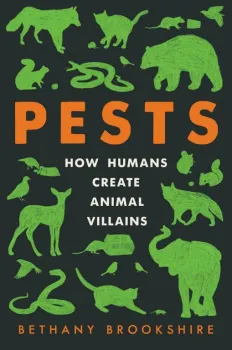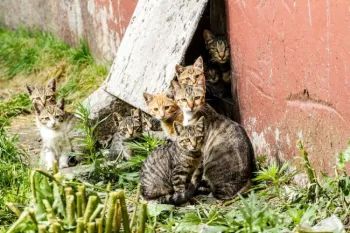“Pests: How Humans Create Animal Villains”
Author: Bethany Brookshire, PhD
348 pages, published by New York City: Harper Collins, 2022

The chapters in this book cover a wide range of animals that the reader may or may not consider a pest. From the introduction where Ms. Brookshire explores the idea of what a pest might be (Introduction – A Pest Is ….. ?) through chapters that explore the domesticity, urban compatibility, and natural tendencies of animals/pests like rats, snakes, mice, pigeons, elephants, cats, coyotes, sparrows, deer, and bears, the reader is consistently challenged to think about what constitutes a pest. Ms. Brookshire's writing is supported through a rich selection of reference aids such as footnotes, indices, and suggested further readings.
This publication is many things, but it is not a landscape or gardening handbook, manual, or text. The reader needs to extrapolate the information offered to the landscapes, gardens, and nature around them to help them decide what they might classify as a pest, and why. The style is highly readable. Information is provided in a folksy, anecdotal, humorous manner where, for instance, prolific breeders are characterized as “horny” and “in the moonlight they go looking for love in all the wrong places,” yet scholarly and sometimes esoteric vocabulary and references are made to coprophagia, microbiome, geotropism, biodiversity, ecosystem, and harm mitigation.
A collection of “nibbles and bits,” or a hodge podge of factoid asides from a few of the chapters follows.
Rodents: From page 5, we learn that “There are over fifty species of rats and not all rats are created equal.” Rat genealogy tells us that the earliest rats, black rats, originated in southern India and prefer hot weather. They are smaller but with longer tails and inhabit roofs and treetops. Meanwhile, brown rats come from Northern China, prefer cold weather, are larger with shorter tails, and inhabit sewers and basements. Because of rat infestations, the city of New York has established a civil service post entitled “The Rat Czar.”
Mice: The author states that the speed, IQ, and moxie of the common house mouse has made it the most successful pest on the planet. Its ability to develop behavioral flexibility, to adapt in a constantly changing world, and its rapid reproduction rate (typically ten litters per year, twelve offspring per litter – 120 babies per pair) has allowed for the proliferation. Even more prevalent than the rat, the house mouse can be found everywhere, from the Arctic to the Antarctic.
Pigeons: Also known as rock doves and urban chickens, squab (young pigeons) are often sold as a delicacy. Pigeons were once commissioned as trusted carrier messengers. Dovecotes, pigeonaire, or just plain pigeon houses have been constructed on properties and rooftops to raise these birds for both food and service. Whether or not pigeons are a pest is often in the eye of the beholder. A scene in the musical Mary Poppins features an elderly street woman hawking birdseed for “tuppence a bag,” while the two most frequent discussion points at city meetings across the country are the homeless and the pigeons. (p. 89) In fact it was the NYC parks commissioner Tom Hoving, quoted in the 6-22-1966 NY Times, who first referred to pigeons as “rats with wings.” (p. 91)
Sparrows: In the late 1950s Chinese Chairman Mao initiated a blight campaign targeting sparrows who were seen to consume seed grain. However, with sparrow demise, insects proliferated and devoured the fields triggering the great famine of 1960 in which some 28 million people starved to death. The Cultural Revolution and the Great Leap Forward failed to foresee this unintended consequence.

Snakes:Judaeo Christian tradition casts the serpent in a dark light through the biblical reference from the book of Genesis. Hindu culture, on the other hand, reveres the snake affording it sacred status. Despite its sacred status and prior to being recognized as a protected species, the British, while governing India, offered a cobra bounty. The hope was to minimize the number of cobras thus mitigating the perceived health/safety threat. The plan did not have the anticipated result since many people, now incentivized, bred cobras at home, turned them in, and received a monetary reward.
Coyote: As dense forest fell and wolves were driven away, coyote filled the void locating a niche in both suburban and rural settings. As humans moved closer to nature the issue of trespass grew more nuanced. Fladry, the attachment of cloth strips to blow in the wind, is popular as a barnyard deterrent. Cloaking pets in neon bristled spiked vests to deter coyote attacks has also been an accepted tactic to protect pets from harm.
Deer: The author states that the most dangerous encounter in North America is hitting a white tail deer with a vehicle. Annually, this results in 440 deaths and 1 billion dollars in casualty claims. (p. 228) The National Agriculture Statistic Service estimates $765 million each year in field crop, orchard, and vineyard production is lost to wild animals. Half of this is probably due to deer. US Forest Service laments that secondary growth is stymied by these nibblers. (p. 243) The yearly total of 400,000 cases of Lymes Disease does not bolster Bambi's fan club.
So, what is a pest? It seems some animals serve a purpose and are helpful to humanity. Some are seen as food. Others violate our space, our boundaries. Some intrude and impose on our lives. Others are just an annoyance or nuisance. Some animals present a threat or a problem towards the health and/or safety of humans, while others may challenge our power or control. Are we being hypocrites? We are both dismayed by yet adore nature and wildlife. Pests are proof not that nature is out to get us, but that nature is all around us. Take a look at this tome and decide for yourself, just what is a pest?

